

Where we give aid. Why Australia gives overseas aid. Australia and overseas aid: A question of giving. Why does Australia give aid?
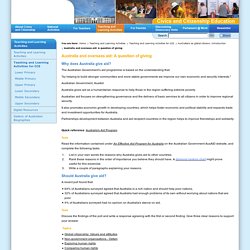
The Australian Government’s aid programme is based on the understanding that: "by helping to build stronger communities and more stable governments we improve our own economic and security interests. " Australian Government, AusAid Australia gives aid as a humanitarian response to help those in the region suffering extreme poverty. Australian Foreign Aid. The state of Australian aid Australia’s aid program has been the disproportionate victim of the Coalition government budget savings measures since forming government in 2013.
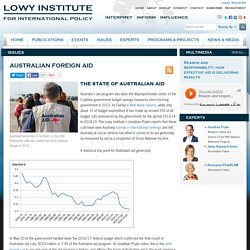
As Fairfax’s Matt Wade reports, while only about 1% of budget expenditure it has made up around 25% of all budget cuts announced by the government for the period 2013-14 to 2018-19. Where Australia gives aid - ABS - 2012. Australia's foreign aid spending: how much and where? – get the data. Australian aid funds this mobile eye clinic in Bali, Indonesia.
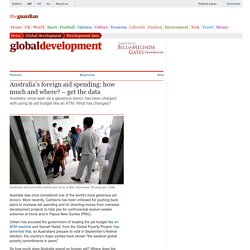
Photograph: Getty Australia was once considered one of the world's most generous aid donors. More recently, Canberra has been criticised for pushing back plans to increase aid spending and for diverting money from overseas development projects to help pay for controversial asylum-seeker schemes at home and in Papua New Guinea (PNG). Oxfam has accused the government of treating the aid budget like an ATM machine and Samah Hadid, from the Global Poverty Project, has lamented that, as Australians prepare to vote in September's federal election, the country's major parties have shown "the weakest global poverty commitments in years".
Australia's aid program. The Australian Government’s development policy Australian aid: promoting prosperity, reducing poverty, enhancing stability and performance framework Making Performance Count: enhancing the accountability and effectiveness of Australian aid outline key aspects of our aid program.

Documents Australia's development policy and performance framework are available in PDF and Word formats. The need for change The world has changed—and our aid program is changing too. Today, many developing countries are growing rapidly, with aid representing an increasingly small proportion of development finance. Sustainable Development Goals.
Australia's aid contribution in Asia. Where we give aid. Overview of Australia's Pacific Regional aid program. How we are helping 2015-16 Total Australian ODA Estimate$124.7 million* 2016-17 Pacific Regional Budget Estimate$149.8 million* 2016-17 Total Australian ODA Estimate$131.6 million** Australia will provide an estimated $149.8 million in 2016-17 to the Pacific through our Pacific Regional Program.
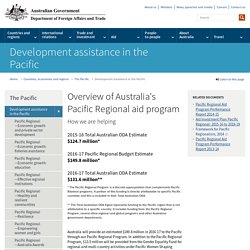
In addition to the Pacific Regional Program, $13.5 million will be provided from the Gender Equality Fund for regional and multi-country activities under Pacific Women Shaping Pacific Development. The Pacific Regional Program complements our Pacific bilateral programs in support of a stable, secure and prosperous Pacific. Many of the Pacific's challenges cannot be addressed solely on a country-by-country basis.
Working with regional organisations and a range of other partners, our program is organised around the following mutually reinforcing objectives as outlined in the Pacific Regional Aid Investment Plan. Objective 1: Economic growth Fisheries assistance in the Pacific region. Cuts to Australian aid. East Asia and Pacific. Connecting the World's Poor to Their Potential. Habitat For Humanity Australia. Habitat for Humanity Australia is part of Habitat for Humanity, an international not-for-profit which originated in Georgia, United States in 1976.

Our Vision: Habitat for Humanity International’s vision is a world where everyone has a safe and decent place to live. Anchored by the conviction that safe and affordable housing provides a path out of poverty, Habitat has helped more than 6.8 million people obtain safe and decent housing, along with the strength, stability and independence to build better lives. Our Mission: To demonstrate God’s love in action by mobilising partner families, volunteers and corporate partners to provide appropriate housing solutions in sustainable communities. We believe it all starts at home At Habitat for Humanity Australia, we believe a stable, secure home creates the foundation for change.
Building a house for one family, changes the lives of so many more. We provide a hand-up not a hand-out. Microfinance Opportunities in India. FSD partners with several community-led organizations in the Udaipur and Jodhpur regions to increase economic opportunity for underserved populations.

These grassroots initiatives offer thousands of marginalized groups the training, financial resources, and job opportunities needed to rise out of poverty. To read about employment and Microfinance issues in India, click here. Interns, volunteers, and donors work with FSD to provide support for programs that: Microfinance in Asia and the Pacific: 12 Things to Know. Microcredit. How Australian aid in Asia can benefit those at home : theconversation. AUSTRALIA IN ASIA: In the fourth part of our series, Deakin University’s Matthew Clarke examines why more Australian aid to Asia would improve regional security.
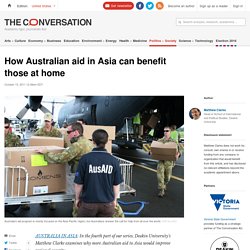
Australians are a generous lot. On a per capita basis, public donations to help those affected by natural disasters are amongst the highest in the world. And the government provides a substantial aid budget too, although its motives may include more than just seeking to reduce poverty. Public donations Studies show that it doesn’t hinge on where emergencies occur or what type they are, Australians will respond to appeals for aid. Non-government organisations receive around $1 billion a year from the public, with nearly one in twenty Australians donating on a monthly basis to child sponsorship or similar fund-raising schemes. List of Australian accredited non-government organisations (NGOs)
Our Work. Where can you find the most poverty-stricken people in the world?
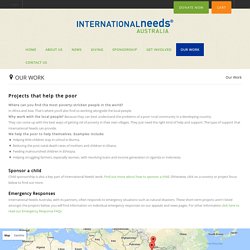
In Africa and Asia. That’s where you’ll also find us working alongside the local people.Why work with the local people? Because they can best understand the problems of a poor rural community in a developing country. They can come up with the best ways of getting rid of poverty in their own villages. They just need the right kind of help and support. Sponsor a child Child sponsorship is also a key part of International Needs’ work. Emergency Responses International Needs Australia, with its partners, often responds to emergency situations such as natural disasters.
Why Australia should fund foreign aid. Opinion Updated Foreign aid is the logical outcome of our prosperous and democratic culture.

The Coalition's decision to cut foreign aid is one that quietly brings into question the humanism that underpins that culture, writes Joe McKenzie. In 2010 David Cameron, the conservative British prime minister, embarked on a policy of savage austerity that fundamentally altered the size and scope of the UK's government and continues to be a defining reason why Britain remains in recession today. The cuts that Cameron made utterly dwarf anything that Joe Hockey could imagine, let alone politically enact, yet he refused to cut the budget of two departments, the National Health Service and foreign aid. He has suffered a political price for it too. Meanwhile, in Australia, the LNP has announced that it will cut $4.5 billion from the foreign aid budget and will instead invest in roads. The saddest thing is that the LNP did not lose a single vote for this.